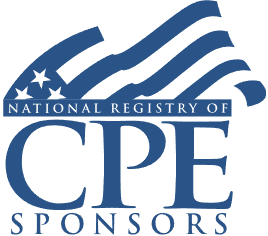Trusts as S Corporation Shareholders: Elections, Eligibility, and Avoiding Loss of Subchapter S Status
QSSTs, ESBTs, Grantor Trusts, and Testamentary Trusts

Welcome! Strafford is now BARBRI! The expert courses you know from the trusted global leader in legal education.
Course Details
- smart_display Format
On-Demand
- signal_cellular_alt Difficulty Level
Intermediate
- work Practice Area
Tax Preparer
- event Date
Monday, June 10, 2024
- schedule Time
1:00 p.m. ET./10:00 a.m. PT
- timer Program Length
110 minutes
-
BARBRI is a NASBA CPE sponsor and this 110-minute webinar is accredited for 2.0 CPE credits.
-
BARBRI is an IRS-approved continuing education provider offering certified courses for Enrolled Agents (EA) and Tax Return Preparers (RTRP).
This course will cover types of trusts eligible to hold S corporation shares, including Qualified Subchapter S Trusts (QSSTs) and Electing Small Business Trusts (ESBTs), making the corresponding QSST and ESBT elections, and avoiding common scenarios where S status is inadvertently terminated when a trust holds shares.
Faculty

Mr. DeStefano raws on his background in private equity finance and portfolio management at a multibillion-dollar foundation to advise public company executives, emerging growth company founders and private investors across the country on building and sustaining a family legacy over multiple generations.

Ms. Simons represents individuals and multi-generational families. She primarily focuses on tax planning, drafting complex wills and trusts, implementing wealth preservation strategies, and charitable giving.

Mr. Weeg, partner with Comiter Singer, is Board Certified in both Tax Law and in Wills, Trusts and Estates and is also a licensed CPA. His law practice includes drafting wills and trusts; advising on income, gift, estate, and GST tax issues; forming business and nonprofit entities; and probating estates. Mr. Weeg is experienced in the preparation of gift and estate tax returns, representation of executors in all phases of estate administration, and creating comprehensive estate plans tailored to meet clients’ personal objectives in a tax efficient manner. He is licensed to practice law in Florida and Texas.
Description
Trusts are viable S corporation shareholders. Grantor trusts, testamentary trusts, QSSTs, and ESBTs, are all eligible to hold S corporation shares. Owning S corporation stock through a trust, or transferring the shares to a trust at death, can be an effective method of transferring ownership. IRC Section 645(b)(2) provides a two-year transition period for certain trusts upon the death of an S corporation shareholder.
A QSST can be an S corporation shareholder. A QSST must meet specific criteria, including having a single income beneficiary and distributing all income currently to the said beneficiary. An ESBT could be a better alternative for owners wanting to distribute or accumulate income to multiple beneficiaries, for example, children. Both QSSTs and ESBTs require timely, properly filed elections. Both are allowed to hold property other than the S corporation stock creating a bifurcated reporting obligation.
There are many circumstances involving trusts that can create the inadvertent termination of the S election. These include leaving S corporation stock to an ineligible shareholder (a foreign trust, IRA, NRA) or even including a defective provision in the trust document. Tax advisers working with S corporations and S corporation shareholders need to recognize the caveats of establishing trusts as shareholders of S corporations for living and testamentary trusts.
Listen as our panel of Subchapter S veterans explains the concerns and considerations of having a trust as an S corporation shareholder.
Outline
- Trusts as S corporation shareholders: overview
- Trust eligibility
- QSSTs
- ESBTs
- Practical considerations
- Avoiding inadvertent terminations of S status
Benefits
The panel will review these and other critical issues:
- General reporting requirements and bifurcated reporting when a QSST or ESBT holds other assets
- Properly filing QSST and ESBT elections
- Eligibility requirements for a QSST and ESBT
- Trust language to avoid jeopardizing S corporation status
NASBA Details
Learning Objectives
After completing this course, you will be able to:
- Recognize various types of trusts eligible to be S corp shareholders
- Verify that QSSTs and ESBTs are properly and timely filed
- Distinguish between QSSTs and ESBTs
- Avoid the inadvertent termination of S status
- Determine the best method of obtaining relief from inadvertent S corp terminations
- Field of Study: Taxes
- Level of Knowledge: Intermediate
- Advance Preparation: None
- Teaching Method: Seminar/Lecture
- Delivery Method: Group-Internet (via computer)
- Attendance Monitoring Method: Attendance is monitored electronically via a participant's PIN and through a series of attendance verification prompts displayed throughout the program
- Prerequisite: Three years+ business or public firm experience preparing complex tax forms and schedules, supervising other preparers or accountants. Specific knowledge and understanding of pass-through taxation, including taxation of partnerships, S corporations and their respective partners and shareholders.

Strafford Publications, Inc. is registered with the National Association of State Boards of Accountancy (NASBA) as a sponsor of continuing professional education on the National Registry of CPE Sponsors. State boards of Accountancy have final authority on the acceptance of individual courses for CPE Credits. Complaints regarding registered sponsons may be submitted to NASBA through its website: www.nasbaregistry.org.

Strafford is an IRS-approved continuing education provider offering certified courses for Enrolled Agents (EA) and Tax Return Preparers (RTRP).
Unlimited access to premium CLE courses:
- Annual access
- Available live and on-demand
- Best for attorneys and legal professionals
Unlimited access to premium CPE courses.:
- Annual access
- Available live and on-demand
- Best for CPAs and tax professionals
Unlimited access to premium CLE, CPE, Professional Skills and Practice-Ready courses.:
- Annual access
- Available live and on-demand
- Best for legal, accounting, and tax professionals
Unlimited access to Professional Skills and Practice-Ready courses:
- Annual access
- Available on-demand
- Best for new attorneys
Related Courses

Redemptions of Partnership Interests: Sections 736(b) vs. 736(a)
Friday, October 31, 2025
1:00 p.m. ET./10:00 a.m. PT

Multistate Tax Treatment of Multi-Tier Partnerships: Ingesting PTET in a Multi-Tier Entity
Friday, September 19, 2025
1:00 p.m. ET./10:00 a.m. PT

IRA Distributions and RMDs: Minimizing Taxes and Meeting SECURE 2.0 Requirements
Available On-Demand

Avoiding Gift and Estate Audit Triggers: Anticipating Audit Issues, IDRs, and Appeals
Tuesday, September 9, 2025
1:00 p.m. ET./10:00 a.m. PT
Recommended Resources
How CPE Can Bridge the Gap Between What You Know and What You Need to Know
- Career Advancement